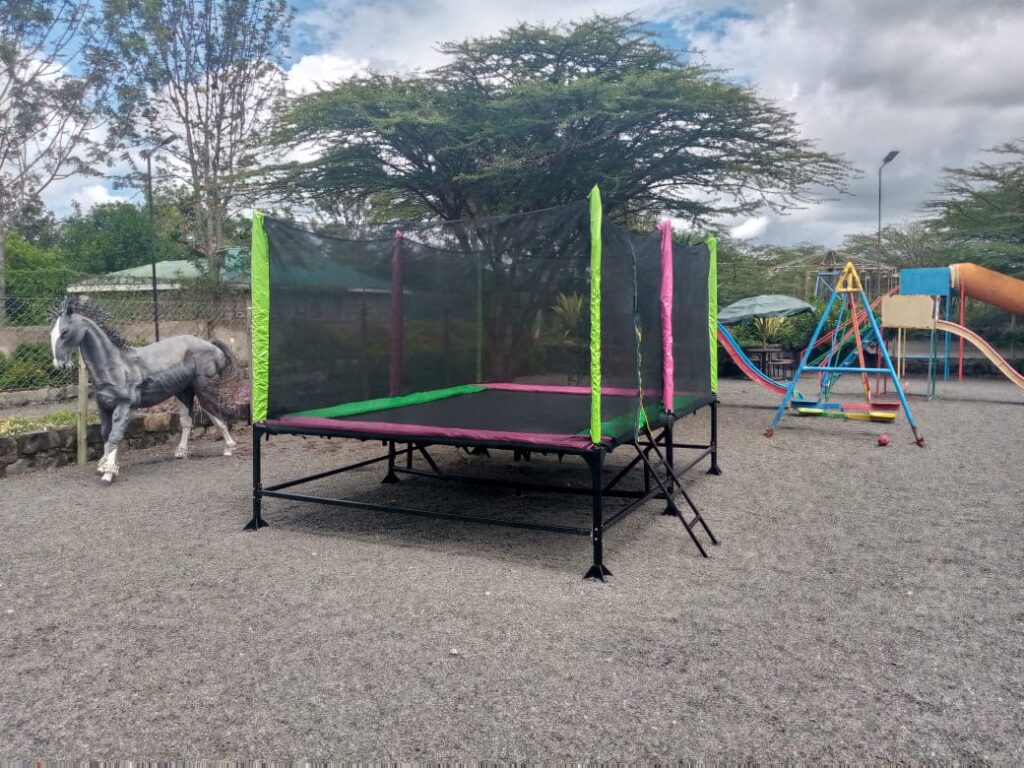The Trampoline Dealer with a Difference in Kenya

If you’re looking to invest in recreational equipment that guarantees both safety and durability, heavy duty commercial trampolines Kenya are the way to go. Designed to withstand rigorous use and varying weather conditions, these trampolines are perfect for commercial use, whether in schools, parks, or entertainment centers.
For Heavy duty commercial trampolines ( Commercial Trampolines or Deluxe Jumbo Trampoline) contact us at
Why Choose Heavy Duty Trampolines?
When it comes to durable trampolines Kenya, these products stand out due to their robust construction and high-quality materials. The frames are typically made from galvanized steel, providing exceptional strength and resistance to rust, ensuring they last for years even when exposed to the elements. The strong trampolines Kenya market offers products that can handle significant weight and continuous use without compromising on safety.
Features of Outdoor Trampolines in Kenya
For those seeking outdoor trampolines in Kenya, heavy-duty models offer unparalleled resilience. They are equipped with heavy-duty bounce mats that are UV-resistant and designed to provide a consistent, high-performance bounce. This makes them ideal for both recreational and professional use, offering a safe and enjoyable experience for all users.
Read Also: Heavy Duty Trampolines in Kenya
The Best Options Available for Heavy Duty Commercial Trampolines in Nairobi Kenya
In the trampolines Kenya market, there are numerous options to choose from. However, if you are looking for the best trampolines in Kenya, focusing on heavy duty models ensures that you are investing in quality. These trampolines not only provide superior performance but also come with enhanced safety features such as reinforced stitching, robust enclosure nets, and stable bases.
Availability and Suppliers
Finding trampolines for sale Kenya is easier than ever, with a variety of suppliers offering a range of models. Kenyan trampoline suppliers provide detailed information about their products, ensuring that you can make an informed decision. Whether you are looking for heavy duty trampolines Nairobi or anywhere else in the country, there are plenty of options to suit your needs.
Factors to Consider when choosing heavy commercial trampolines in Kenya
When planning to buy trampolines Kenya, it’s important to consider several factors, including size, weight capacity, and intended use. Heavy duty garden trampolines Kenya are perfect for large backyards and can accommodate multiple users at once. Additionally, checking trampoline prices Kenya helps in finding a model that fits within your budget without compromising on quality.
Investing in high quality trampolines Kenya is a decision that ensures safety, durability, and enjoyment for years to come. Whether for commercial use or personal enjoyment, heavy duty outdoor trampolines provide a reliable and fun way to stay active. With numerous options available from Kenyan trampoline suppliers, you can find the perfect trampoline to meet your needs and budget.
For Quality and Durable Trampolines in Kenya also check out our affiliate site at Thrifty Enterprises Kenya
Looking to add a dash of excitement to your life in Nakuru, Kenya? Welcome to Frugal Innovations, where we specialize in bringing joy and adventure right to your doorstep with our premium selection of trampolines. Whether you’re searching for an indoor trampoline in Nakuru, Kenya, or an outdoor trampoline in Nakuru, Kenya, we’ve got you covered with unbeatable prices and exceptional quality. We supply all types of trampolines in Nakuru Kenya
Contact Us for Trampolines in Nakuru Kenya
Buy Cheap Trampolines In Nakuru Kenya
At Frugal Innovations, we understand that fun shouldn’t come with a hefty price tag, which is why we’re proud to offer a range of trampolines to suit every budget. From cheap trampolines in Nakuru, Kenya perfect for backyard play to high-end models for professional use, we believe that everyone deserves the chance to experience the thrill of bouncing.
Our showroom is stocked with an impressive array of trampolines designed to cater to all ages and preferences. Whether you’re a seasoned jumper or a first-time bouncer, our friendly staff are on hand to help you find the perfect trampoline to suit your needs.
For those seeking an adrenaline rush indoors, our indoor trampolines in Nakuru, Kenya offer the perfect solution. Compact, versatile, and safe, these trampolines are ideal for rainy days or when you simply want to bounce to your heart’s content without worrying about the weather.
Outdoor Trampolines in Nakuru Kenya
Prefer to take the fun outdoors? Our outdoor trampolines in Nakuru, Kenya are built to withstand the elements while providing hours of entertainment for the whole family. Whether you’re hosting a birthday party, family reunion, or neighborhood barbecue, our trampolines are sure to be the highlight of the event.
At Frugal Innovations, customer satisfaction is our top priority. We believe in providing not only top-quality products but also exceptional service every step of the way. From assisting you in selecting the perfect trampoline to ensuring speedy delivery and expert installation, we’re committed to making your shopping experience with us a breeze.
So why wait? Visit Frugal Innovations today and discover the joy of bouncing with our premium trampolines in Nakuru, Kenya. With unbeatable prices, exceptional quality, and friendly service, we’re your ultimate destination for all things trampoline-related. Get ready to elevate your fun and experience the thrill of flight with Frugal Innovations!
- Where to Repair Trampolines in Kenya: Fast, Affordable, Professional Services by Frugal Innovations Kenya
- How to Safely Repair a Sun-Faded or UV-Damaged Trampoline Mat in Kenya
- Are Trampolines the Next Big Fitness Asset for Kenyan Women?
- How Nairobi’s Dust and Wind Patterns Affect Trampoline Lifespan — Best Trampoline Repairs in Kenya
- How to Start a Trampoline Hire Business in Nairobi — Costs, Earnings, Risks, Competition


